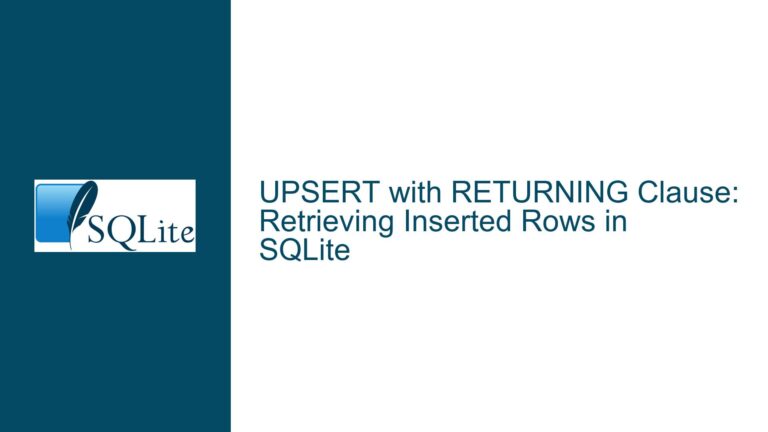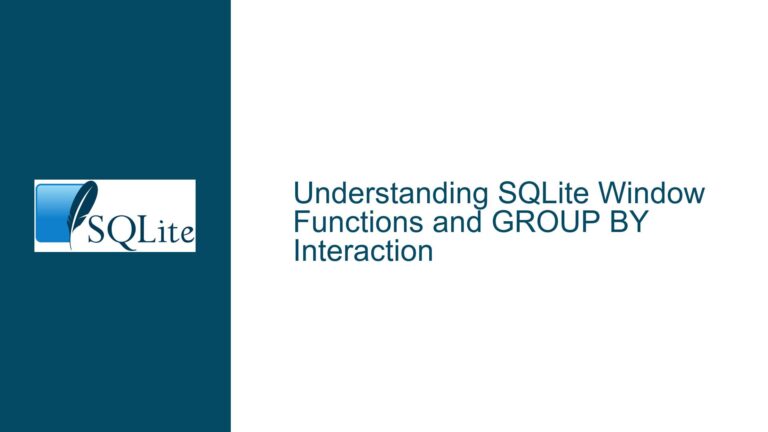Unexpected Comparison Results When Combining CAST and COLLATE BINARY in SQLite
Understanding Type Affinity, Collation, and Comparison Semantics in SQLite
SQLite’s dynamic type system and implicit conversion rules often lead to subtle edge cases when combining operations like CAST and collations such as COLLATE BINARY. A common scenario involves discrepancies between expected and actual results when comparing values of mixed storage classes (e.g., numeric and text). This guide dissects the root causes of these issues, explains why they occur, and provides actionable solutions to align query behavior with expectations.
1. Core Mechanics of SQLite Type Affinity and Collation
Type Affinity and Storage Classes
SQLite employs a dynamic type system where columns and expressions have a type affinity (e.g., INTEGER, TEXT, NONE) that influences how values are stored and compared. The five storage classes—NULL, INTEGER, REAL, TEXT, and BLOB—determine the actual representation of data. When comparing values, SQLite applies type affinity rules to coerce values into a common storage class before evaluation.
For example:
CAST(1 AS INTEGER)explicitly sets the affinity toINTEGER, coercing the value to the INTEGER storage class.- The literal
'1'has no inherent affinity (treated asTEXTunless influenced by context).
Collation Sequences and Their Scope
Collation defines how text values are compared. The COLLATE BINARY clause specifies a binary comparison where characters are compared using their underlying byte values. Critically, collation applies only to operands of the TEXT storage class. If an operand is not TEXT, the collation is ignored, and the comparison proceeds using type affinity rules.
Interaction Between CAST and COLLATE
The CAST operator alters the type affinity of an expression, which in turn affects how collation is applied. When COLLATE is chained after CAST, the collation is only relevant if the result of CAST is TEXT. For non-TEXT results (e.g., CAST(... AS INT)), the collation clause has no effect, and SQLite defaults to type affinity-based comparison.
2. Root Causes of Mismatched Comparison Results
Implicit Type Conversion Overrides Collation
Consider the query:
SELECT ((CAST(1 AS INT)) COLLATE BINARY) == '1';
Here, CAST(1 AS INT) produces an INTEGER storage class. The COLLATE BINARY clause is attached to this INTEGER value, but since collation applies only to TEXT, SQLite ignores it. The comparison INTEGER == '1' triggers implicit conversion: the TEXT value '1' is coerced to INTEGER 1, resulting in 1 == 1 (true).
Misunderstanding Collation Applicability
Developers often assume that COLLATE BINARY forces a textual comparison regardless of operand types. This is incorrect. Collation modifies how text is compared, not whether values are treated as text. If one operand is non-TEXT, collation does not influence the comparison.
Type Affinity Hierarchy in Comparisons
SQLite follows these rules when comparing values:
- If one operand has INTEGER, REAL, or NUMERIC affinity, the other operand is converted to a numeric type.
- If one operand is TEXT and the other has no affinity, the comparison uses text semantics.
- BLOB values are compared verbatim.
In the example, the left operand (CAST(1 AS INT)) has INTEGER affinity, so the right operand ('1') is converted to INTEGER, bypassing collation entirely.
3. Resolving Comparison Issues with CAST and COLLATE
Step 1: Diagnose Storage Classes and Affinities
Use the typeof() function to inspect the storage class of expressions:
SELECT typeof(CAST(1 AS INT)), typeof('1');
-- Returns: 'integer', 'text'
This reveals that CAST(1 AS INT) is INTEGER, not TEXT. Attaching COLLATE BINARY to an INTEGER has no effect.
Step 2: Ensure Collation Operates on TEXT Values
To enforce a textual comparison, ensure both operands are TEXT:
SELECT (CAST(1 AS TEXT) COLLATE BINARY) == '1'; -- Returns 1 (true)
Here, CAST(1 AS TEXT) converts the value to TEXT, allowing COLLATE BINARY to take effect. The comparison becomes '1' == '1' (true).
For a case-sensitive mismatch:
SELECT (CAST(1 AS TEXT) COLLATE BINARY) == 'A1'; -- Returns 0 (false)
Step 3: Avoid Implicit Conversion in Comparisons
To compare values as text without numeric conversion, explicitly cast both operands to TEXT:
SELECT CAST(1 AS TEXT) == CAST('1' AS TEXT); -- Returns 1 (true)
SELECT CAST(1 AS TEXT) == CAST('A1' AS TEXT); -- Returns 0 (false)
Step 4: Use Explicit Collation for Text-Specific Logic
When comparing mixed-type columns, apply collation only after ensuring TEXT affinity:
SELECT column1 COLLATE BINARY == column2
WHERE typeof(column1) = 'text' AND typeof(column2) = 'text';
Step 5: Leverage STRICT Tables for Type Enforcement
In SQLite 3.37+, STRICT tables enforce column types, preventing implicit conversions:
CREATE TABLE strict_table (id INT, value TEXT) STRICT;
INSERT INTO strict_table VALUES (1, '1');
SELECT id == value FROM strict_table; -- Returns 0 (false: INTEGER vs TEXT)
Step 6: Utilize CASE Expressions for Conditional Typing
Handle mixed-type comparisons programmatically:
SELECT CASE
WHEN typeof(col1) = 'integer' AND typeof(col2) = 'text' THEN
col1 == CAST(col2 AS INTEGER)
ELSE
col1 == col2 COLLATE BINARY
END;
Final Solution for the Original Query
To achieve the expected result (0), force a textual comparison by casting to TEXT:
SELECT (CAST(1 AS TEXT) COLLATE BINARY) == '1'; -- Returns 1 (still true)
-- To get 0, compare to a non-numeric text value:
SELECT (CAST(1 AS TEXT) COLLATE BINARY) == 'A1'; -- Returns 0
If the goal is to prevent numeric coercion, ensure both operands are TEXT and use COLLATE BINARY only when necessary.
By understanding SQLite’s type affinity hierarchy, the limited scope of collation, and the interplay between CAST and storage classes, developers can write precise queries that align with their comparison logic requirements.






